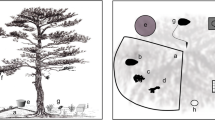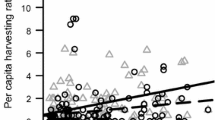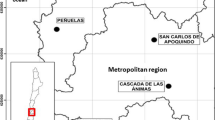Abstract
The effect of predispersal seed predation by Bruchus atomarius (Bruchidae, Coleoptera) on individual performance and population dynamics of the perennial forest herb, Lathyrus vernus (Leguminosae), was investigated in 11 permanent plots over 4 years. Seed predation and parameters describing intra-specific neighbour distance, plant size, inflorescence size, flowering phenology and current and previous herbivore damage were measured on all plants. In addition, demographic information from all plots was analysed using transition matrix population models in order to estimate the influence of seed predation on population growth rates. Predispersal seed predation rates differed significantly among years. Plot averages ranged from 0 to 83.7%. However, most of the variation occurred among individuals. Within individuals there was no consistency in predation rates among years. Exposure to herbivory, plant size and flowering phenology did not affect predation rates but individuals with larger inflorescences suffered from significantly higher predation. Seed predation in L. vernus was not influenced by neighbour distances of individual plants but it was positively correlated with the average density of seeds within plots, suggesting that seed predation is density dependent at the patch level. The reduction in population growth rate due to seed predation ranged from 0 to 7.6%. The sensitivity of population growth rate to reductions in seed production varied considerably among years and plots. This variation was mainly due to differences in the reproductive value of seeds and seedlings. The intensity of seed predation over the range found was not correlated with changes in population growth rate. The results of this study suggest that the influence of external factors, like seed predation, on population growth rate largely depends on the demographic transition rates in the investigated population.
Similar content being viewed by others
References
Augspurger CK (1981) Reproductive synchrony of a tropical shrub: experimental studies on effects of pollinators and seed predators on Hybanthus prunifolius (Violaceae). Ecology 62:775–788
Bengtsson K (1993) Funmana procumbens on Öland-population dynamics of a disjunct species at the northern limit of its range. J Ecol 81:745–758
Bierzychudek P (1982) The demography of jack-in-the-pulpit, a forest perennial that changes sex. Ecol Monogr 52:335–351
Bullock JM, Clear Hill B, Silvertown J (1994) Demography of Cirsium vulgare in a grazing experiment. J Ecol 82:101–111
Calvo RN (1993) Evolutionary demography of orchids: intensity and frequency of pollination and the cost of fruiting. Ecology 74:1033–1042
Caswell H (1989) Matrix population models: construction, analysis and interpretation. Sinauer, Sunderland
Crawley MJ (1989) Insect herbivores and plant population dynamics. Annu Rev Entomol 34:531–564
Crawley MJ (1992) Seed predators and plant population dynamics. In: Fenner M (ed) Seeds, the ecology of regeneration in plant communities. CAB International, Wallingford, pp 157–191
Ehrlén J (1992) Proximate limits to seed production in a herbaceous perennial legume, Lathyrus vernus. Ecology 73:1820–1831
Ehrlén J (1993) Ultimate functions of non-fruiting flowers in Lathyrus vernus. Oikos 68:45–52
Ehrlén J (1994) Herbivory, pollen limitation and population dynamics in Lathyrus vernus. PhD thesis, Department of Botany, University of Stockholm, Sweden
Ehrlén J (1995a) Demography of the perennial herb Lathyrus vernus. I. Herbivory and individual performance. J Ecol 83:287–295
Ehrlén J (1995b) Demography of the perennial herb Lathyrus vernus. II. Herbivory and population dynamics. J Ecol 83:297–308
Ehrlén J, Eriksson O (1995) Pollen limitation and population growth in a herbaceous perennial legume. Ecology 76:652–656
Ehrlén J, Eriksson O (1996) Seedling recruitment in the perennial herb Lathyrus vernus. Flora 191, in press
Evans EW, Smith CC, Gendron RP (1989) Timing of reproduction in a prairie legume: seasonal impacts of insects consuming flowers and seeds. Oecologia 78:220–230
Fowler NL (1995) Density-dependent demography in two grasses: a five-year study. Ecology 76:2145–2164
Hainsworth FR, Wolf LL, Mercier T (1984) Pollination and predispersal seed predation: net effects on reproduction and inflorescence characteristics in Ipomopsis aggregata. Oecologia 63:405–409
Harper JL (1977) Population biology of plants. Academic Press, London
Horvitz CC, Schemske DW (1995) Spatiotemporal variation in demographic transitions of a tropical understory herb: projection matrix analysis. Ecol Monogr 65:155–192
Louda SM (1982) Limitation of the recruitment of the shrub Haplopappus squarrosus (Asteraceae) by flower- and seed-feeding insects. J Ecol 70:43–53
Louda SM (1983) Seed predation and seedling mortality in the recruitment of a shrub, Haplopappus venetus (Asteraceae), along a climatic gradient. Ecology 64:511–521
Louda SM, Potvin MA (1995) Effect of inflorescence-feeding insects on the demography and lifetime fitness of a native plant. Ecology 76:229–245
Molau U, Eriksen B, Teilmann Knudsen J (1989) Predispersal seed predation in Bartsia alpina. Oecologia 81:181–185
Moloney KA (1988) Fine-scale spatial and temporal variation in the demography of a perennial bunchgrass. Ecology 69:1588–1598
O'Dowd DJ, Gill AM (1984) Predator satiation and site alteration following fire: mass reproduction of alpine ash (Eucalyptus delegatensis) in southeastern Australia. Ecology 65:1052–1066
Pettersson MW (1994) Large plant size counteracts early seed predation during the extended flowering season of a Silene uniflora (Caryophyllaceae) population. Ecography 17:264–271
Sheppard AW, Cullen JM, Aeschlimann JP (1994) Predispersal seed predation on Carduus nutans (Asteraceae) in southern Europe. Acta Oecol 15:529–541
Solbreck C, Sillén-Tullberg B (1986) Seed production and seed predation in a patchy and time-varying environment. Dynamics of a milkweed-tephritid fly system. Oecologia 71:51–58
Traveset A (1991) Pre-dispersal seed predation in Central American Acacia farnesiana: factors affecting the abundance of cooccurring bruchid beetles. Oecologia 87:570–576
Werner PA, Caswell H (1977) Population growth rates and age versus stage distribution models for teasel (Dipsacus sylvestris Huds.). Ecology 58:1103–1111
Wright SJ (1990) Cumulative satiation of a seed predator over the fruiting season of its host. Oikos 58:272–276
Zimmerman M (1980) Reproduction in Polemonium: pre-dispersal seed predation. Ecology 61:502–506
Author information
Authors and Affiliations
Rights and permissions
About this article
Cite this article
Ehrlén, J. Spatiotemporal variation in predispersal seed predation intensity. Oecologia 108, 708–713 (1996). https://doi.org/10.1007/BF00329046
Received:
Accepted:
Issue Date:
DOI: https://doi.org/10.1007/BF00329046




